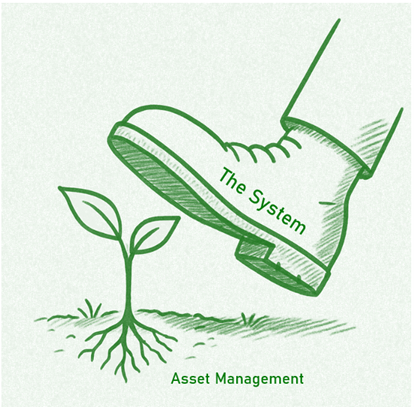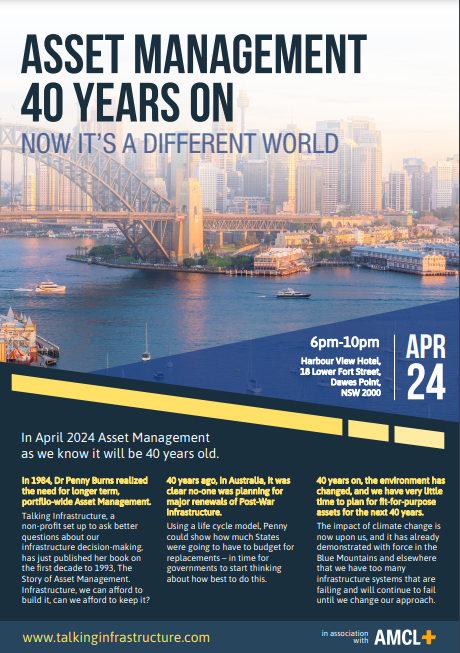Julie and I produced this after a recent discussion with Ruth. I think it’s a discussion we’ve been having for years.

Todd Shepherd & Julie DeYoung
Once upon a time, or so the story goes, Asset Management started to take sprout at our organizations with a bold promise. It came to guide us toward long-term thinking, to help us look beyond next year’s budget and into the decades ahead. It came with principles and frameworks, a philosophy that assets are not isolated items, but interconnected parts of a whole. The decisions we make today shape the quality of life for future generations. It was a different way of seeing how investing in the right place, at the right time, could save money, and public trust.
But then Asset Management met The System. And The System did what it always does: it absorbed the new idea and bent it back into something familiar.
Instead of being a strategy for long-term stewardship, Asset Management became a new label for what we were already doing. We turned it into a more refined version of the same habits: squeezing the last bit of life out of aging assets, reacting quickly to failures, and deferring investment until the next crisis hit. We framed these actions as efficiency, as cost savings, as smart business. But they were just survival tactics. And so, when Asset Management started to bloom, it was quietly, subtly, reshaped.
What was meant to be transformational became transactional.
Long-term planning? That would have to wait. We needed to fix the latest failure, explain the recent cost overrun, patch the emergency before the news cycle caught wind. The capital planning calendar was full of yesterday’s fires. Asset Management was drafted into service as a better way to react.
Rather than change The System, Asset Management was absorbed by it. It was translated into the language of short-term cost savings and immediate returns. “Get more life out of your assets” became a directive, not to optimize lifecycle value, but to defer replacement as long as humanly possible. And The System applauded. Budgets tightened. Work orders increased. Failure response times improved…until they didn’t.
This isn’t a failure of individuals. It’s what happens when a new idea runs headlong into The System. The System reward firefighting over fire prevention. It promotes leaders who solve today’s crises, not those who quietly prevent tomorrows. It allocates resources to what is visible, immediate, and politically expedient. And so, Asset Management is quietly reshaped until it fits.
A discipline focused on resilience and long-range value becomes a sophisticated way to do what we’ve always done: squeeze, stretch, defer, and repeat.
Asset Management, instead of being a disruptor, became domesticated.
The truth is, Asset Management requires a paradigm shift. It requires a new way of thinking about value, responsibility, and time. It asks us to see past short-term wins and start building for long-term resilience. It asks leaders to stop managing symptoms and start addressing root causes. It asks organizations to measure success not by how fast they respond to failure, but by how rarely failure occurs at all.
That’s a hard shift to make. It means unlearning habits, changing incentives, and having the patience to invest in what won’t pay off this quarter. It means making space for new voices, new metrics, and sometimes uncomfortable truths.
But if we want Asset Management to be more than a buzzword, we need to protect it from the status quo. We need to give it space to grow before we ask it to perform. And most of all, we need to let it change us before we change it.
To do that, leaders must become designers of systems, not just managers of outcomes. They must ask: What behaviors are we rewarding? What stories are we telling? Are we building a future, or just managing decline?
Asset Management didn’t fail. It simply wasn’t given a chance to take root. But the story isn’t over. It’s still being written. And if we’re willing to change the system, we might just change the ending.

At this end of 2024, I am more convinced than ever that the whole point of Asset Management is Planning.
Planning, as opposed to delivery – which we have been doing for decades, if not centuries. Asset Management is about thinking through what we need to deliver across our asset base, Plan before Do. (Don’t just do something, sit there.)
That is what Penny created Asset Management for.
And the central concept was lifecycle modelling, supported by cost-risk-optimisation, matched to understanding demand. When is the right time to replace, renew, maintain? What don’t we need to do?
The AMP has been the centre of Asset Management since the very beginning. As captured in state and federal requirements, as documented in the International Infrastructure Management Manual from the IPWEA.
We need Planning – and it is not going to happen without us.
But it is too often still – after 40 years! – fragmentary, driven by vested interests (even the understandable wish by people on the ground to get money for their own assets).
It doesn’t look at what happens next: ‘And then what?’
And I can count the organisations I work with that actually do lifecycle cost modelling or cost-risk optimisation on the fingers of two hands.
To do the maths on all the major costs, risks and benefits of different options across the lifecycle, and demonstrate that (for example) building back rural roads like for like after they have been washed away for the fourth time in five years simply doesn’t add up.
Time for a Campaign for Honest Asset Management Planning?

Join us at the Harbour View Hotel in the Rocks and help celebrate with finger food and drinks – plus Penny and Jeff on what we have learnt from the last 40 years to help us meet the challenges of the next 40.
Many thanks to Richard Edwards, Lynn Furniss and Matt Miles of AMCL

In April 2024, it will be 40 years since Penny Burns started the whole thing. Talking Infrastructure plans to party like it’s 2024, all year.
2024 also marks milestones for the Global Forum for Maintenance and Asset Management (update of the AM Landscape), ISO (10 years since ISO 55000), and the Institute of Asset Management (30 years since it was founded): there will be a lot happening.
The need for more considered decision making for our future infrastructure has only grown and become more urgent. Asset Managers everywhere know this. Our 40 year celebration will be an opportunity to take this message not only to managers of infrastructure but also to those who decide, design, construct, fund and vote for our infrastructure.
Like infrastructure itself, our purpose is to support the wider community. There is a lot of satisfaction to be had in this and we invite you to join us, and enjoy it too. What area of Asset Management and decision making particularly interests you?
We are looking to develop a circle of advisors, who, through their interests and work, can have the fun of keeping Talking infrastructure up to date with current issues, and setting its future directions.
Your ideas for celebrating our 40th are also needed and much welcomed. This will include events across Australia in April, and presence at AM conferences and articles wherever and whenever we can.
What did we learn in the last forty years? Where do we need to go in the next 40 years?

From Bill Wallsgrove
AI continues to not quite to get what a platypus is – just as many people still don’t understand what Asset Managers do.
I could tell two miserable current stories of Human Resources not getting it. A major power utility with ISO 55000 certification where HR led a structure reorganisation, and failed to include any Asset Management (and the saddest part was how much effort the AM team had put into trying to bring HR along with them). A transit agency where HR insist they know better how to recruit good Asset Managers – again, after years of effort from the AM team on what to look for.
But lamenting HR failures is like shooting fish in barrel: too easy.
And we are all still working it out.
For example, looking at AM teams where they have really done interesting things, I see how much difference ‘professional’ information skills have made. The most impressive Asset Managers I know include a librarian, an ex-military intelligence veteran, and a teacher of data science. I wonder if good Asset Management is even possible without information nous.
And the perennial questions of whether you can learn to ‘embrace uncertainty’, or think strategically. Are good Asset Managers born, not made? I don’t want to believe so.
I certainly don’t have it all and have depended through my career on other people with complementary skills to mine.
As the Institute of Asset Management (IAM) starts its review of its Competency Framework, to update and expand the original work led by Chris Lloyd, I get the feeling more than ever that it isn’t just a matter of hiring people with certain skills, but of encouraging those who think about the world in particular ways.
I’m on the Competences Steering Group for the IAM. This is a plea for input: what is your experience on the most important skills, experience, aptitudes, attitudes for good Infrastructure Asset Management?
What have we learnt about good people in the nearly 40 years of Asset Management?

I work with a variety of organisations in several countries who are attempting to implement good Asset Management. Some are just starting out. A few are quite sophisticated. And one or two are even tackling the question of infrastructure decision making in our communities.
I was struck again this month by how hard this all sometimes seems.
Organizations who are just starting out have interesting challenges, of course, including no-one much understanding what AM is and, usually, a lack of resources. One half time resource without much authority, for example, can’t do much to radically transform their business.
But surely it doesn’t have to be that hard, conceptually, to sort out a basic asset inventory, classic Wave 1? Plenty of organisations have already sorted that – it is, as my old colleague John Lavan put it, a puzzle, for which there is an answer already known, not a problem we haven’t yet solved.
And yet many people just don’t seem to have good sense about asset information. And want to reduce the problem to basic IT, which they also don’t do very well. (I am feeling a bit grumpy about this: can’t someone please donate good-enough asset hierarchies and principles into the public domain, or even write the book so no-one ever has to reinvent those particular wheels? TJ, Dave Ulrich, I am looking at you guys here.)
Wave 2, strategic AM and better all-round asset decision-making also depends on something rather more than technology – and that, I am sure, is why organisations struggle. It involves people! Culture! And politics, small p, and sometimes Big P too!
Where Asset Management is effective, infrastructure Asset Managers can then get caught up in Wave 3. And however smart and well-resourced they are, it’s big.
A great current example is electric buses, something the US Federal government wants to throw money at as part of ‘decarbonization’ of transport. But the questions of how, and why, to invest with all the interconnecting issues of the infrastructure for the buses themselves, performance and customer satisfaction, and whether this will even give the right carbon-reduced answer…
Asset Managers get it. But they are a small drop in a large ocean of greed and love of shiny new things.
I asked a buddy who’s simply caught in too many stupid business decisions in a utility whether he might just bring in some additional resources to tackle more of them… But he said, quite rightly, where from? Who gets it, and all the diplomacy, strategic thinking, experience, intelligent use of what data there is that is that’s required, all at once?
ISO 55000 doesn’t help it all that much.
In a new series of blogs, I want to look with your input at some of the challenges we see in every Wave. Of course we love challenges. But I also see rather too many Asset Managers at every stage drowning in the sheer size of the job.
Series to include: asset information, risk, networking, attitude change, and more.

“We donʼt get the recognition we deserve” the council’s maintenance guy told me. “Nobody ever says, ‘Thanks!’”
But why would they when you have just told them your organisation has an insurmountable renewal gap in its road assets?”
We have to wonder if presenting problems without solutions is really what asset management is about. What if a brain surgeon told you that you have a brain tumour but nothing could be done about it, would you say ʻthanksʼ? Or would you be inclined to downgrade his expertise, seek a second opinion and/or wallow in the misery of the diagnosis? If so, why should councils be any different?
If, however, your brain surgeon said: ʻYou have a brain tumour, it is tricky, but we can operate and there is an excellent chance that, if you follow the regime that I will give you, you will recover well.ʼ Would you now say a heartfelt ʻThanks!!’ Indeed you would. Again, why should councils be any different?
We now have models that enable easy prediction of future asset renewal. It really is ʻplug and playʼ, we put in the raw data and, hey presto, out come the answers. These projected asset renewal costs will generally be far above the capacity of the organisation to finance, so we cannot stop there. Providing this ʻraw dataʼ is NOT the end of the Asset Management task, merely a preliminary data input.
A Solution?
Suppose now that you say to your council. “This is the current state of the asset renewal gap. The figures represent the cost of continuing to do things the way we have always done them in the past. This problem has built up over many years and it will take a number of years to correct, but with your support and using the asset management tools and knowledge we now have, we can reduce this gap to manageable levels.
As a bonus, what if, at the end of the year, you are able to recalculate the gap and demonstrate that you have made, say, a 10% or 20% reduction, and that, with actions already in hand, you are on track to reduce the gap even further in the following year, do you think that they will now say: “THANKS!”? Of course. You have now done something worth thanking.
Asset Management is not about presenting problems – it is about addressing them.
This was ten years ago. Where are we today?

Recent Comments